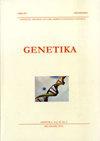印度喜玛拉雅西北地区白三叶草(Trifolium repens L.)多样性及生态位模型研究
4区 农林科学
Q3 Agricultural and Biological Sciences
引用次数: 0
摘要
Trifolium repens L.,俗称白三叶草,是温带地区重要的匍匐茎多年生豆科植物之一。在农业生态系统中引入草料豆科植物可使土壤富氮并调动其他养分。此外,它在帮助恢复温带草原和减少喜马拉雅地区严重的饲料短缺方面具有巨大的潜力。近几十年来,包括白三叶草在内的牧草种质资源的收集和开发一直是研究人员关注的焦点。由于种质已储存在国家基因库的长期模块中,因此收集的材料应作为未来不同改进方案的安全储存库。在本研究中,利用生态位建模的最大熵(MaxEnt)技术,在印度喜马拉雅地区(包括查谟-克什米尔、喜马偕尔邦和北阿坎德邦)探索白三叶草种质资源可能的新采集区,并确定有利的气候条件,以进行表征、种植、评估和农场保护。株高(15.5 ~ 37.6 cm)、每穗小花数(9.24 ~ 52.4)、百粒重(0.038 ~ 0.077)、单株干物质产量(6.2 ~ 15.1 g)、叶长(15.6 ~ 48.4 mm)、叶宽(11.2 ~ 39.6 mm)差异显著。非常显著的变化也观察到?V?标记。基于平均链接法,Dendrogram将22个条目分成两类。集群I由IC-615818、IC- 615817、IC-622352、IC-615815和IC-622362 5个成员组成,集群II可分为子集群iia和子集群IIB。集群IIA由6个成员组成(IC- 622338、IC-622379、IC-622382、IC-622401、IC-622343和IC-62237),而集群iib由11个成员组成(IC- 615814、IC- 615811、IC-615819、IC-622376、IC-622383、IC-615812、IC-622385、IC-615816、IC- 615817、IC-622415和IC-622406)。在这项研究中,利用生态位建模的最大熵(MaxEnt)技术来探索白三叶草种质资源可能的新收集区域,确定包括查谟克什米尔联邦领土、喜马偕尔邦和北阿坎德邦在内的印度喜马拉雅地区的有利气候,以进行表征、种植和评估以及农场保护。本文章由计算机程序翻译,如有差异,请以英文原文为准。
Diversity and ecological niche modelling studies in Trifolium repens L. (White clover) in the region of north-western Himalaya, India
Trifolium repens L., commonly referred as white clover, is one of the important stoloniferous perennial range legume growing in temperate regions. The introduction of forage legumes in agro-ecosystem provides nitrogen enrichment in soil and mobilizes other nutrients. Further, it has a tremendous potential to help rehabilitate temperate grasslands and decrease the severe fodder shortage in the Himalayan region. In recent decades, collecting and exploration of forage species germplasm, including white clover, have been in the focus of researchers. The collected material shall act as a safe repository for different improvement programmes in future as the germplasm has been stored in the Long Term Module of the National Gene Bank. In this study, maximum entropy (MaxEnt) technique of niche modelling was used to explore probable new areas for the collection of white clover germplasm and identify favorable climate for characterization, cultivation, evaluation and on-farm conservation in the Indian Himalayan region, which comprises the of Jammu Kashmir and Himachal Pradesh and Uttarakhand. Significant variation was observed in plant height (15.5 to 37.6 cm), floret number per flower head (9.24 to 52.4), 100 seed weight (0.038 to 0.077), dry matter yield per plant (6.2 to 15.1 g), leaf length (15.6 to 48.4 mm), leaf width (11.2 to 39.6 mm). Very highly significant variation was also observed in ?V? marking. Dendrogram grouped the 22 accessions into two clusters based on the average linking method. Cluster I consisted of five accessions (IC-615818, IC- 615817,IC-622352, IC-615815, and IC-622362), cluster- II could be grouped into sub-cluster-IIA and sub-cluster- IIB. Cluster IIA consist of six accessions (IC- 622338, IC-622379, IC-622382, IC-622401, IC-622343 and IC-62237), whereas cluster-IIB comprise of 11 accessions (IC- 615814 IC- 615811, IC-615819, IC-622376, IC-622383, IC-615812, IC-622385, IC-615816, IC- 615817, IC-622415 and IC-622406). In this study, maximum entropy (MaxEnt) technique of niche modelling was used to explore probable new areas for the collection of white clover germplasm, identifying favorable climate for characterization, cultivation & evaluation and on-farm conservation in the Indian Himalayan region comprising the Union Territory of Jammu Kashmir and the states of Himachal Pradesh and Uttarakhand.
求助全文
通过发布文献求助,成功后即可免费获取论文全文。
去求助
来源期刊

Genetika-Belgrade
AGRONOMY-GENETICS & HEREDITY
CiteScore
1.80
自引率
0.00%
发文量
1
审稿时长
6-12 weeks
期刊介绍:
The GENETIKA is dedicated to genetic studies of all organisms including genetics of microorganisms, plant genetics, animal genetics, human genetics, molecular genetics, genomics, functional genomics, plant and animal breeding, population and evolutionary genetics, mutagenesis and genotoxicology and biotechnology.
 求助内容:
求助内容: 应助结果提醒方式:
应助结果提醒方式:


